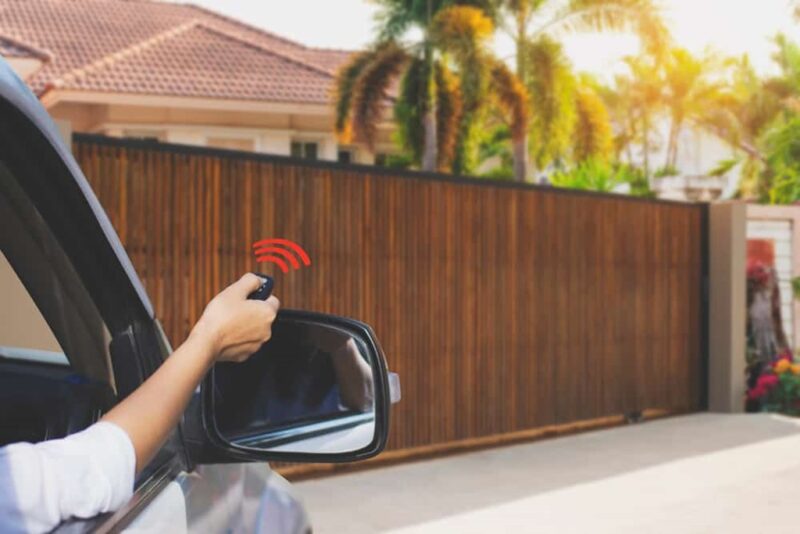Opening your garage door with the push of a button is one of those simple modern conveniences we take for granted. But behind that seemingly effortless operation is a complex system of garage door sensors and other hardware that work together to ensure your garage opens and closes safely and securely.
In this article, we’ll take a look under the hood to understand the technology that makes automatic garage doors function properly. Knowing how garage door sensors work can help you troubleshoot issues if your system acts up, and determine when repairs or upgrades may be needed.
An Overview of Garage Door Sensors
Automatic garage door openers utilize a combination of sensors to detect objects, monitor position, and trigger actions like opening, closing, stopping, and reversing. Here are some of the most important sensors in a typical system:
- Door movement sensors – These monitor whether the door is opening or closing, and send signals to start or stop the motor accordingly. They include limit switches and Hall Effect sensors.
- Obstruction detection sensors – Obstruction sensors detect when something is blocking the path of the door to prevent damage or injury. Common options are infrared beams and resistance/force sensors.
- Safety sensors – Also called photo eyes, safety sensors project infrared beams across the doorway to detect when something — or someone — is in the path of a closing door.
- Tilt sensors – Tilt sensors monitor the orientation of the door and can trigger it to stop or reverse if the door is at an abnormal angle, like when something obstructs its path.
- Remote sensors – Sensors on the wall-mounted control panel detect signals from remote transmitters to open, close, or otherwise operate the door.
Now that we’ve seen a high-level overview of the sensor types, let’s look at how each one functions and contributes to the seamless operation of your automatic garage door.
Monitoring Door Movement: Limit Switches and Hall Effect Sensors
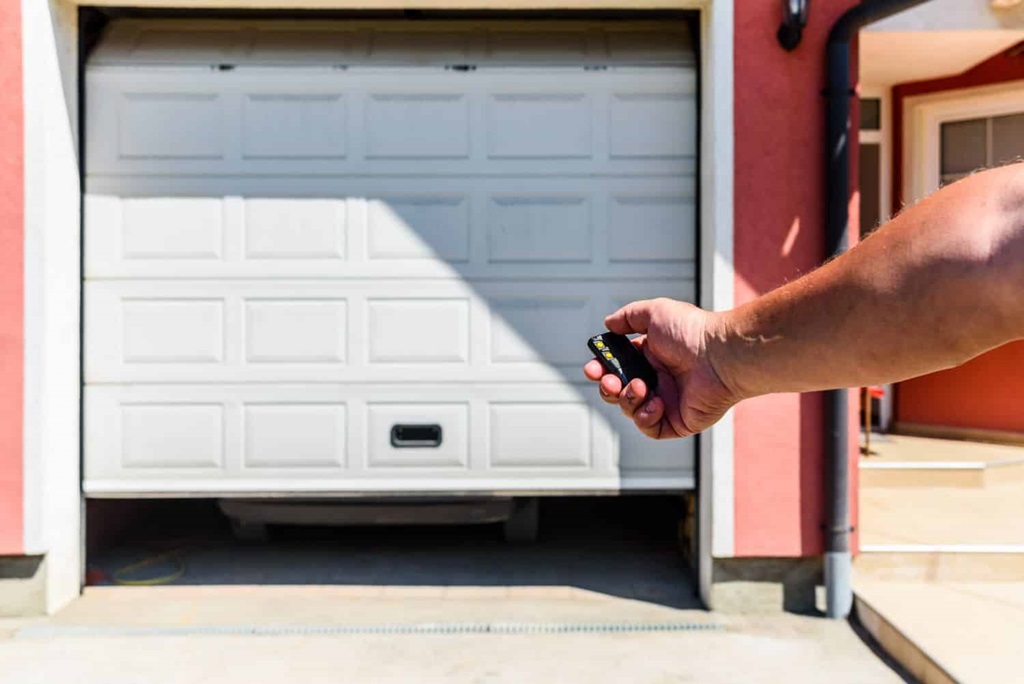
To open and close on command, an automatic garage door needs to monitor its position and motion. This is achieved through two main types of sensors:
Limit Switches
Limit switches are simple electromechanical devices that sit inside the motor assembly. When the door reaches the fully open or fully closed position, the limit switch is physically triggered by a piece attached to the moving door.
Think of them like an on-off switch. The motor runs in one direction until the fully open switch is flipped by the door’s motion, then stops. To close the door, the process happens in reverse until the closed switch is triggered. This signals the motor to stop.
Limit switches contain metal lever arms that extend into the path of the door opener. As the door moves, these levers get pushed into the switch body, activating internal electrical contacts to control the circuit. The levers are spring-loaded so they snap back into place after the door passes.
Limit switches are simple and inexpensive, but they also have some downsides:
- They can wear out over time and break. Repeated mechanical triggering of the lever arm eventually causes failure.
- They have to be manually adjusted when the travel limits need recalibration. For example, if you get new garage door springs installed or make other repairs that change how far the door opens and closes.
- Debris and dirt can get into the switch over years of exposure and cause malfunction or seizure.
For these reasons, upgraded modern garage door openers often add another type of door travel sensor.
Hall Effect Sensors
Hall effect sensors have no moving parts and determine position magnetically. They consist of a semiconductor chip with an output wire that transmits a voltage signal when exposed to a magnetic field.
A small magnet passes by the sensor chip as the door moves. When the magnet is close enough, the chip toggles the output voltage to high or low, indicating whether the door is at the open or closed position.
Benefits of Hall Effect sensors:
- They are more durable since nothing moves or makes mechanical contact.
- No adjustments are needed when door limits change. The sensor simply detects when the magnet reaches its chip.
- They resist moisture, dirt, and corrosion since they are sealed solid-state devices.
Using both limit switches and Hall effect sensors together provides redundancy. If one type fails, the other acts as a backup to avoid getting stuck with an operable garage door.
Now that we’ve seen how door travel is monitored, let’s look at the vital sensors that detect obstructions.
Obstruction Detection Sensors
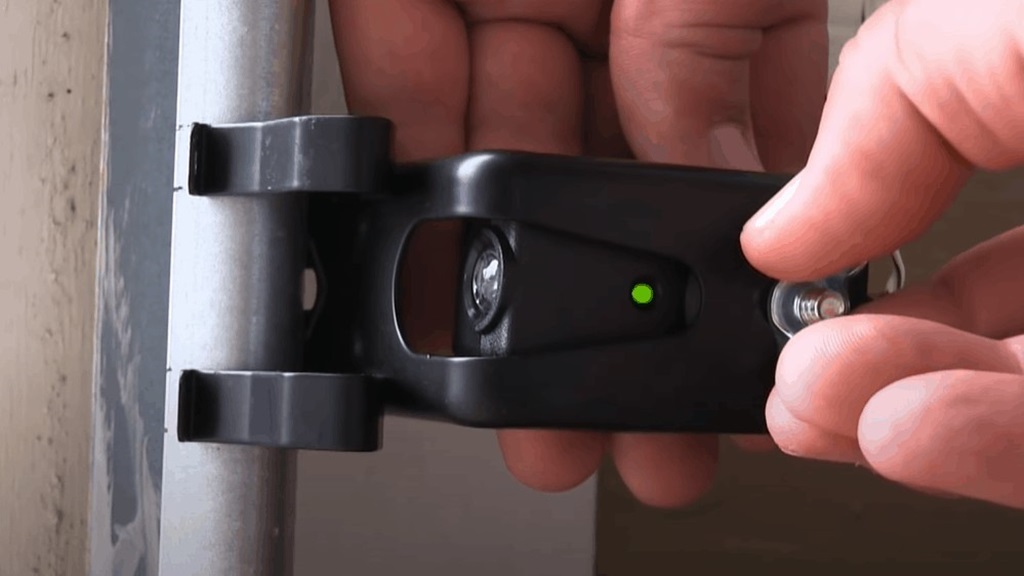
Garage doors have considerable weight and closing force. Without obstruction detection, something or someone could easily get trapped and injured by a closing door. Automatic openers use two main technologies to detect obstructions and prevent accidents: infrared beams and current sensing.
Infrared Beam Sensors
Infrared beam systems project multiple invisible light beams across the door opening. If one of the beams gets disrupted, it means something is obstructing the doorway, and the motor will stop or reverse direction.
Infrared sensors consist of an emitter unit that generates the light beam, and a receiver on the opposite side that detects the beam. When an object breaks the light path between them, the receiver signals the control board to take action.
Infrared technology provides responsive obstruction detection. The instant an object blocks a beam, it triggers without needing to contact the object physically. This prevents damage and squeezes by pets, blowing debris, and other things that temporarily obstruct the opening.
The downsides of infrared beam sensors include:
- Alignment can drift over time and cause beams to miss the receiver, leading to phantom obstructions or failure to detect legitimate ones.
- Visible light from the sun or headlights can blind some receivers and interfere with proper operation. Newer models filter infrared only to avoid this issue.
- Any dirt or cobwebs blocking the “line of sight” between emitters and receivers can disrupt the infrared beams.
To compensate for these limitations, most modern openers also incorporate a backup obstruction detection method.
Resistance or Force Sensing
Resistance and force detection technologies monitor the electric current or mechanical resistance as the motor runs. When the door encounters an obstruction that causes resistance, an increased current draw is detected, or changes in motor speed trigger the door to stop or reverse.
Force sensing has some advantages over infrared beams:
- It continues working even when beams are misaligned or dirty.
- It detects obstructions on the full surface of the door, instead of just along the plane of the beams.
- No adjustments or calibration are required since force detection is based on electrical/mechanical resistance.
Together, infrared and force sensing provide overlapping protection across the opening and surface of the door. Now let’s look at a critical third layer of safety sensors.
The Laser-Focused Purpose of Safety Sensors
Safety sensors, or photo eyes as they are commonly called, have a very targeted purpose separate from the general obstruction detection sensors we just covered.
While infrared beams and force sensing try to detect obstructions before the door makes contact, they ultimately react at the last second to prevent crushing whatever is underneath. Safety sensors, on the other hand, are designed to detect the presence of an obstruction before the door even begins closing in the first place.
How Safety Sensors Work
Safety sensors consist of two small units that face each other across the bottom of the garage door opening. An infrared beam runs between them, projecting across the opening around 4-6 inches above the ground.
If this beam is interrupted, it means something is still under the door, and it will not close. The door can only begin the close cycle when the safety sensors detect that the doorway is clear.
This provides an added layer of protection against accidents, especially involving children and pets who might run under a closing overhead door. Safety sensors won’t necessarily prevent injuries in that scenario, but they will halt the door closing prematurely before it makes contact.
Why Safety Sensors Are Necessary
You might be wondering why safety sensors are needed when obstruction detection already stops the door if something is under it. Here are two good reasons:
Reaction time – By the time obstruction sensors detect something and reverse, the door is already moving under momentum and has partially descended on the obstruction. This still poses a risk of injury. But if safety sensors detect a presence before movement starts, accidents can be avoided altogether.
Sensor failure – If the other obstruction detection sensors fail for some reason, the safety sensor beam provides a redundancy to prevent the door from closing on people or pets. Safety sensors have to function properly for the door to close at all.
Now let’s look at one more category of specialty sensors you’ll find on many garage door systems.
Tilt Sensors That Detect Trouble
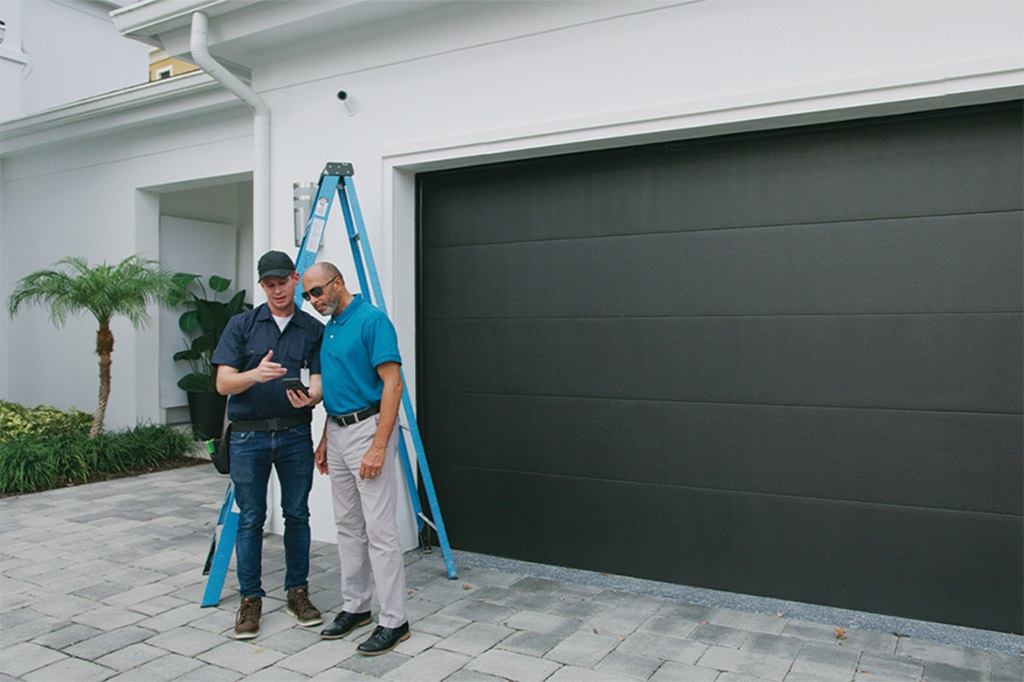
In addition to sensors that monitor motion and obstructions, most modern garage door openers also contain tilt sensors. These are simple devices that do exactly what their name implies – they detect when the door is tilted at an abnormal angle.
This can happen if something obstructs the door during movement, causing it to bind and tilt off track. When the tilt sensor detects this condition, it will trigger the motor to stop and reverse direction to prevent damage.
Tilt sensors typically consist of a metal ball inside a small tube. When the door tilts, gravity causes the ball to press against the end of the tube, closing an electrical circuit that sends a signal to the control board.
Abnormal tilting may indicate obstacles inside the garage that are blocking movement, broken springs that can no longer lift the door, or tracks that need alignment. The tilt sensor provides feedback that service is required to address these issues.
Some garage door opener brands combine the tilt sensor right inside the motor housing itself to save space and simplify installation.
Now that we’ve covered the major internal sensor types, let’s look at how the system receives commands from the external control panel.
Remote Control Sensors Decode Signals
The conveniently compact remote controls that operate your garage door from afar do their magic through radio-frequency (RF) signals and sensors.
When you push the remote button, it transmits an encoded RF signal that contains the command (open, close, etc). At the wall control panel, a sensor picks up this wireless signal through a small antenna.
The sensor circuitry decodes the command and relays it to the opener to trigger the corresponding action only if the code matches the system. This prevents neighbors’ remotes from infiltrating your garage.
The RF receiver sensor must be compatible with the specific frequency and encryption of your remote controls. Common frequencies include 300-400 MHz and 900 MHz. Many new openers provide both options.
Some other features of advanced remote and receiver systems include:
- Multiple remotes – Control panels store codes for all your remote clickers to authorize each one.
- Keyless entry pads – Wireless keypads can alternatively enter access codes without a physical remote.
- Vehicle remote integrations – Homelink systems built into cars can directly control the garage door.
- Longer range – Extended range receivers allow remotes to function up to 1000 ft away.
Now let’s look at a common problem that applies to both remote and safety sensor signals.
Interference Can Disrupt Wireless Signals
Garage door sensors that rely on wireless signals can be impacted by interference that degrades or blocks communication:
- RF interference – Other radio signals in proximity to the opener frequency can cause static, blocking remote commands or scrambling safety sensor beams.
- WiFi interference – High levels of WiFi signal near the garage may infiltrate remote or safety sensor bands.
- Metal barriers – Heavily insulated garage doors with metal layers or foil insulation can block radio signals passing through.
Solutions include:
- Installing an antenna extension to position the receiver away from interference sources.
- Upgrading to a dual-frequency (300/900 MHz) receiver less prone to specific interference.
- Adding exterior keypads and safety sensors so signals transmit directly through the open doorway.
- Using shielded safety sensor wiring less susceptible to RF noise infiltration.
Proper placement and orientation of all wireless transmitter/receiver pairs is also important to establish strong communication.
Now that we’ve covered the critical internal and external sensors that drive your garage door system, let’s look at some key maintenance tips to keep them functioning at their best.
Sensor Maintenance to Prevent Problems
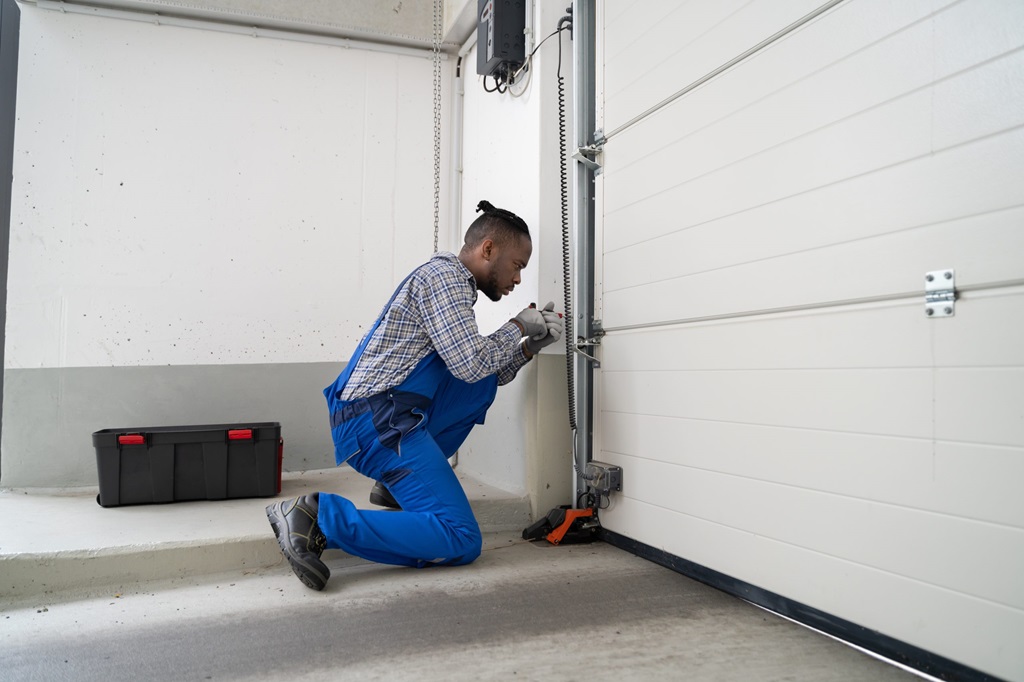
Garage door sensors are designed for durability, but periodic maintenance is still recommended:
- Check alignment – Make sure infrared beam emitters and receivers face each other properly across door openings. Visually follow beams to confirm unobstructed pathways.
- Clean sensors – Gently wipe lens covers on safety sensors and infrared obstruction detectors to remove dirt, spiderwebs, and other debris that can disrupt optical signals.
- Test functionality – Trigger each sensor intentionally to check that the opener responds accordingly by stopping and reversing when beams are blocked.
- Check connections – Ensure wires leading to and from sensors are securely plugged in. Loose connections can cause intermittent signal loss.
- Watch for damage – Inspect sensors for any cracked lenses or casings that could let in moisture and short out circuits.
- Replace batteries – For battery-powered sensors, swap out depleted batteries at least once a year to maintain strong wireless signals.
Performing proactive sensor checks and maintenance every 6 months can prevent many functional problems and safety risks.
Now let’s answer some common questions about garage door sensors.
Conclusion
Modern automatic garage doors rely on an elaborate system of sensors working in harmony to provide safe, reliable operation at the push of a button. Limit switches, Hall effect sensors, infrared beams, safety sensors, tilt detectors, and wireless remotes each play a specialized role in controlling door movement, monitoring obstructions, and providing user access.
While the technology behind your seamless garage door experience is sophisticated, following proper installation guidelines and maintaining sensors through periodic cleaning and testing can prevent many frustrations and keep your system running smoothly for years to come. A little sensor savvy will ensure you have a trouble-free transition from driveway to garage.
Frequently Asked Questions
Do both safety sensors need to work for the garage door to close?
Yes, both the emitter and receiver sides of the safety sensors must be intact, aligned, and communicating properly for the door to close. This fail-safe design prevents operation if one side loses power or gets damaged.
What happens if the safety sensor beam gets blocked?
If the safety sensor infrared beam gets interrupted while the door is closing, it will reverse direction back open immediately. The door will not close until both sensors re-establish alignment with no obstructions.
Why does my door reverse for no reason?
If your garage door starts reversing randomly even when nothing is obstructing it, the most common cause is misalignment or dirt on one of the safety or infrared beam sensors. Carefully inspect sensor lenses and realign any units that have shifted out of position.
Can I disable the safety sensors?
No, it is hazardous and illegal to disable safety sensors on a garage door system. They are required by building codes and are critical to preventing injury or entrapment accidents. The door opener should not function at all if the safety sensors are not working.
How do I align infrared beam sensors?
Refer to the opener manual for proper installation positions. Rough alignment can be done by eye, then fine-tuning by watching the indicator LEDs on the receiver units while adjusting direction. Alignment is correct when receivers maintain steady LEDs without flickering or interrupting beams.
Why does my remote work only sometimes?
Intermittent remote function is usually caused by low batteries, interference, or exceeding the operating range limit. Try replacing batteries, relocating wireless controls away from interfering devices, and moving closer to the garage door when sending signals. If problems persist, the receiver may need replacement.

